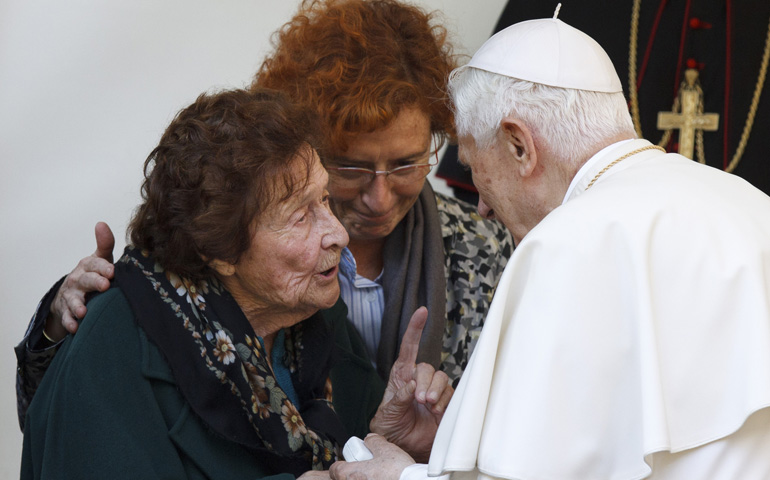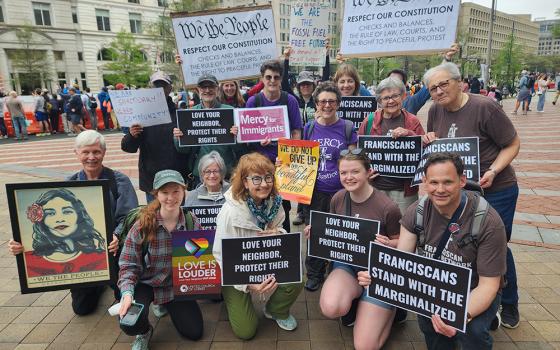
Pope Benedict XVI talks with Enrichetta Vitali, 91, during a visit Monday to a home for the elderly run by the Sant'Egidio Community in Rome. (CNS/Paul Haring)
It's probably tempting to chalk up Pope Benedict XVI's visit to a Roman home for the elderly run by the Community of Sant'Egidio on Monday either as a meaningless photo-op or, at best, as a cute human interest story: The world's most visible elderly man telling fellow senior citizens, "It's beautiful to be old!"
(By the way, I relayed that comment to my 98-year-old grandma, who's now in an assisted living facility and chafing against both physical limits and feelings of isolation. I can't quote her reaction verbatim, as this is a family newspaper, but suffice it to say that though she's a faithful Catholic, she's not quite in full communion with the pontiff on this one.)
Yet anyone who grasps the world's demographic trajectory these days may well view Benedict's outing the same way political reporters saw President Barack Obama's and Gov. Mitt Romney's recent expeditions in Ohio: as high-stakes outreach to the church's most important "swing state."
In this case, the contest isn't for the White House, but for the vitality of Catholicism in the early 21st century.
"The Gray Boom"
That's because the dominant demographic story of our time is what experts call "The Gray Boom."
In its 2005 report "Taking Care: Ethical Caregiving in Our Aging Society," The President's Council on Bioethics reached this sobering conclusion: "In the years ahead, the age structure of advanced industrial societies will be unlike anything previously seen in human history, with both the average age and the absolute number of old people increasing dramatically."
Memorably, the report said we are becoming a "mass geriatric society."
Here are the numbers: According to the Census Bureau, in 2005, there were 60 million Americans under 14, with 34.7 million over 65. By 2050, the number under 14 will stay basically the same, but the 65+ group will have skyrocketed to 75.9 million, a growth rate of 119 percent. The population of "old olds," meaning those above 85, will increase four-fold.
In Europe, the median age by 2050 will be 47.1, and in Japan, a staggering 52.3. One leading Japanese politician has actually proposed exporting retirees to the Philippines in order to relieve the pressure. The same thing is happening outside the West. In the first half of the 21st century, Algeria will go from a median age of 21.7 to 40, an astonishing jump of almost 18 years. In Egypt, by 2050, the elderly will be growing twice as fast as the working age population.
In China, 26 percent of the population will be 60 or older by 2040. Demographers describe China as facing a 4-2-1 problem: Each young adult potentially will be caring for two parents, plus four grandparents. Brazil is aging at a rate 2.1 times that of the United States, and by 2050, 63 million Brazilians will be over 60.
Bottom line: The world is getting much older, much faster than ever before.
A potential bonanza
Most Catholics probably have attended an event recently when someone looked out at the crowd and rued: "Look at all the gray heads!" Given our demographic situation, that's precisely the wrong reaction: In many ways, the elderly are now the church's make-or-break cohort.
Benedict XVI's speech Monday laid a basis for greater outreach.
"The quality of a society, I would say of an entire civilization, can be judged by how the elderly are treated and the place reserved for them in common life," Benedict said. "Whoever welcomes the elderly, welcomes life!"
Such spiritual logic is buttressed by a clear pastoral basis for paying attention to the elderly: They're the ones most likely to show up.
The 65+ group is, by far, the most religious segment of the American population. A U.S. News and World Report/PBS Religion and Ethics Newsweekly survey concluded that 60 percent of Americans aged 65+ attend religious services once a week, compared to 34 percent of those 25-34.
Of course, crossing the 65+ boundary does not magically make someone a believer. Nevertheless, evidence suggests that someone marginally open to religion at 35 is likely to be more so at 65. Sociologists say that a notable uptick in religiosity typically begins in the early thirties and builds as people age.
Here's what this means: By 2030, 6.8 million additional Catholics in the United States will be entering the stage of life where they are most likely to pray, to go to church, to reflect on religious subjects, and to be open to a deeper religious commitment.
The question is, will the church take advantage of this potential bonanza?
To do so, Catholicism will probably need a more "gray-friendly" consciousness. For instance, seminaries may need to encourage homilists to slow down, since elderly parishioners often struggle when someone speaks in rapid-fire fashion. Parishes may need to ensure their facilities are accessible to the disabled and to offer transportation for senior citizens. Even schedules may need to change. Places that cater to younger adults often start events at 7 p.m. or later, but senior citizens might be more comfortable with the early afternoon.
All of this should be worked out locally by talking to the elderly themselves.
None of this, of course, implies that Catholicism should abandon the young. But far from fretting when we see gray heads, hearts ought to gladden. If someone were to dream up a program with the potential to draw 6.8 million American Catholics into deeper practice of the faith, it would be hailed as one of the great missionary success stories of all time.
Today, demographics are to some extent doing the job all by themselves -- if the church has the vision to respond.
* * *
Reports continue to filter out of Syria about the harrowing situation facing Christians there, especially in Aleppo and Homs, where the carnage has been the most intense. As I've written before, Syria's 2.3 million Christians are gripped by fear that they're destined to be the next Iraq -- the next Middle Eastern nation where a police state will fall, and Christians will be among the primary victims of the ensuing chaos.
On Wednesday, veteran Italian journalist Marco Tosatti reported that one challenge facing Catholic parishes is to come up with enough money to ransom the mounting number of Christians kidnapped by militant groups who see extortion as a way to finance their mayhem. It's another force driving Christians out of the country.
American Catholics currently wrapped up in whatever their pet peeve may be -- Cardinal Timothy Dolan's willingness to sit down with Obama at the Al Smith Dinner, for instance, or the new Mass translations, or the LCWR crackdown, or whatever -- may want to ponder that for a minute. However pressing those matters may be, they seem to pale in comparison, and perhaps we should spare a moment's thought for Syria.
An Italian website called Pray for Syria has published a moving set of letters and emails from church personnel who have chosen to stay, including a recent missive from an Incarnate Word missionary in Aleppo. Here are some extracts:
We want to help everyone, but especially the neediest Christians, so they won't feel forced to leave the country, which would mean the absence of a Christian witness in this noble nation – so they won't have to abandon their own land, their roots, their ancestors. For this reason, we're focusing on the Christian families of the "El Midán" neighborhood, one of the hardest-hit zones, and a neighborhood where the Institute of the Incarnate Word has done pastoral work in a church called the "Chapel of the Assumption" for three years. It's one of the poorest parts of Aleppo, and, as I said, one of the most devastated by the fighting; the reason is because the neighborhood is strategically located at the heart of the city. As a result, fighting goes on all the time. The church is especially at risk, because it's near the headquarters of the national police; for that reason, the sisters and residents of the area have been forced to evacuate.
Many of these Christians now don't have a home, they don't have any work, they're penniless, and on top of all that, most of the refugee centers are for Muslims. Although in general co-existence here is good, that doesn't lessen the risk posed by fundamentalist Muslims who are taking advantage of the situation. They're a threat to minorities, and as a result many Christians don't go to the refugee centers out of fear.
In Midán we're trying to offer concrete help to 60 families. These are cases of extreme urgency, because they have neither jobs nor food, and because they have small children or family members suffering from either a physical or mental infirmity. The sick aren't getting any help, either for economic reasons or because the hospitals are overwhelmed. We have to do something. We're asking for support from anyone who, feeling compassion for the situation in Syria, might want to help us help them.
Here's another example from a missionary sister's letter home to her family in Italy. She's also in Aleppo:
In some of the most working class neighborhoods, the power is off up to ten hours a day. There's no fuel, so work is slowly coming to a halt. Gas is incredibly expensive ... A few months ago, a can of gas cost 300 Syrian Pounds, but now it's 3,500. To give you an idea of what that means, the average monthly salary is about 8,000 Syrian Pounds, so a can of gas now costs almost half the normal person's monthly wage! Everything is expensive: food, meat, fruit ... even bread has become hard to find. People are afraid and sad, without much hope. There are many Christians who have left the country, and those few who remain are thinking about how they can get out.
The other day people asked if it made any sense for me to continue this mission, given the situation. Afterwards I put the same question to God in my prayers, and He didn't make me wait long for an answer. Unexpectedly, a lady showed up crying, very worried, asking only to be listened to. Speaking the Arabic dialect of our neighborhood, she only wanted a little advice, a word of consolation, to feel her hand held for a while. Later, the young people of our church asked if they could spend a few days at our house for a change of pace. We said yes, and they had a three-day campout on our grounds.
Even if that doesn't seem like much, our presence alone accomplishes a lot. Our people attach great value to it, and for them it's an example. Those same young people asked us to lead them in Spiritual Exercises. That's another way we can do some good for them, helping them come to know the truth of Christ, the only one who merits being served, and for whose sake it's worth losing everything!
Readers who'd like to do something might consider supporting an emergency appeal from the Catholic Near East Welfare Association, one of the largest providers of humanitarian relief to Christians in Syria. The idea is to supply winter survival kits to 2,000 vulnerable families. Information can be found here.
Anyone wanting to support the Incarnate Word missionaries in Aleppo can find information here (in Italian).




